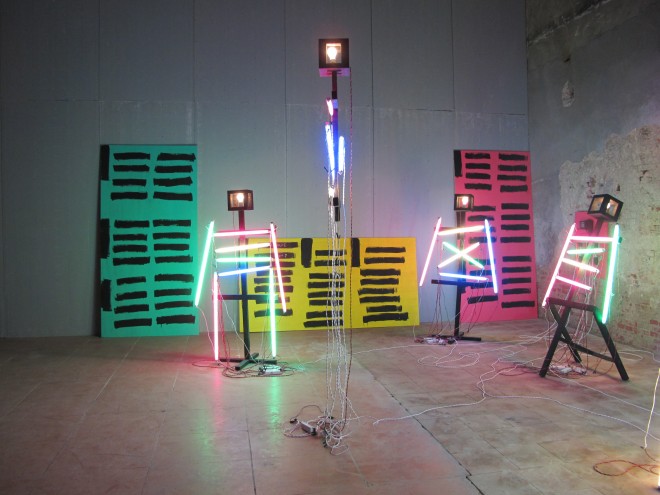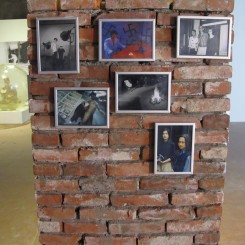I’m Not Involved in Aesthetic Progress: A Rethinking of Performance
Star Gallery, Qikeshu Space (C5 Qikeshu Creative Park, No.55 Banjieta Village, Chaoyang District, 100016, Beijing) Apr 14 – May 16, 2013
It’s easy to see the relationship between the city and the country in Beijing. One minute, you’re driving along the asphalt roads of the city, but as you cross some railroad tracks, you find yourself suddenly in the middle of the dusty countryside. Stretches of brick houses take up your line of sight, but your map contradictorily indicates you are not yet outside the bounds of Beijing’s fifth ring road. Hidden away here, Qikeshu Creative Park is relatively unknown to the public compared to 798 Arts Zone and Caochangdi, but galleries are familiar with the area because it houses the Ullens and Star Gallery warehouses, along with a number of artist studios and photography studios. However, Star Gallery is the first to set up an exhibition space here.
Although the current exhibition is related to performance art, viewers familiar with the course modern art will not find anything new or unexpected on show. But there is something to be said for the novelty of revisiting performance art; especially when said art is has been returned to a “village within the city” environment so similar to its birthplace.

Ma Liuming, “Fen – Ma Liuming in the Instanbul Biennale”, performance video, 2001.
马六明, “芬·马六明在伊斯坦布尔双年展”, 行为,录像 2001.
The works on display range from those recently completed, and others more historical (insofar as works from the relatively short duration of modern art in China can be called historical). The group photograph of Ma Liuming and British performance artists Gilbert & George brings to mind a story both difficult to describe and hard to define. Even though this photograph has been printed in nearly every publication related to modern art in China, its appearance at Qikeshu still manages to evoke an entirely different set of feelings — as if performance art is happening on some random corner of the village, proclaiming the blatant vulnerability of the human form. A screen in the center of the exhibition space shows the artist in another performance piece just seven years later in 2001 at the Istanbul Biennial. Ma Liuming sits naked in the midst of some wooden stools; his head is bowed as he silently awaits interaction from the audience, even allowing individuals to spray him with large amounts of water. In the end, he is picked up and carried away. The difference between the two pieces highlights one incontrovertible truth — time changes all, and slips past without our knowing. In the later piece, Ma Liuming’s physique is already showing the early signs of corpulence, but the greatest transformation is not with his body; instead, it is found in the theme of his work. Human consumption has replaced his theories about the relationship between the physical body and politics. On view at the same time are Xing Danwen’s video recordings of various performance art pieces from the 90s. Seen with our present-day eyes, they seem to belong in some historical text, which further emphasizes the great gap between the days of the Beijing East Village and now. Works recorded range from pieces as moderate as Lin Yilin’s “Safely Maneuvering across Lin He Road” to ones as extreme as Wang Jin’s “To Marry a Mule” (1995).

Chen Shaoxiong, “72.5 Hours of Electricity Consumption”, installation, performance, 1992.
陈劭雄, “耗电72.5小时”, 装置,行为,1992.
“72.5 Hours of Electricity Consumption” (1992) by Chen Shaoxiong is yet another work from the early 90s. It is composed of brightly colored fluorescent lights, which gives the piece a more aesthetic quality. The piece is also distinctive because it involves objects (lights) undertaking the performance instead of human participants. The only true traces of movement are the measured ticks of the electricity meter, changing by the hour. The artist himself has stated his dislike of symbolism and ritual in performance, along with his abhorrence of turning ideology into a performance (according to the exhibition catalogue). Though the artist says his works display a kind of “performance-free performance art,” the humanoid shapes formed by the lights still bring about a kind of symbolism, and even more so, they evoke elements of ritual — surrounded by these figures of light, the viewer experiences a sense of fear and awe. Their very silence is a unique voice in and of itself.
Strictly speaking, Liu Ding’s “performance / video” piece “I Simply Appear in the Company of Other Things” (2012) is superfluous, at least to the current show. The piece is filed under the category of “work” in the treasure trove that is the Tate Modern oil tanks. Carol Yinghua Lu effectively introduces us to Liu Ding’s creative and planning processes by symbolically taking part in a situation that doubles as a performance piece. After she proclaims Liu Ding’s absence, Liu participates in a discussion of himself under the pseudonym “Mr. Liu.” In the end, this piece only demonstrates Carol Yinghua Lu’s unwavering devotion to her husband, Liu Ding.
The above is precisely why it is imperative to “rethink performance” whether as an exhibition or a topic of discussion. Performance art makes symbolic play of the physical body, and serves as a record of this symbolic process. It is valuable because it generates meaning, just as the absence of meaning reduces the impact of performance itself. Today, we discuss performance art not only to pay tribute to the works of those artists, but also to pay tribute to the bygone era which had the ability to generate performance art — an era that allowed performance art to exist in its purest form.

